How To Invest Your Salary?
Build a Big Portfolio Even With a Low Salary

Back in 2011, I worked with a non-profit and made INR 10000 as a salary. But, I could still save and invest. My savings rate was 10%
By 2015, I was working with a consulting firm & made 1.5 Lakh/month.
My savings rate was 30%
By 2023, I make exponentially more, but my savings rate is 95%
There are 2 key points:
1. How much you SAVE (& Invest) is more important than HOW much you MAKE.
2. Your savings rate should ideally grow with your salary levels.
So in this article, let’s discuss: How you can get this equation right.
More specifically, how you can SAVE & INVEST more sensibly, irrespective of your salary levels.
Salary Level 1: You are earning an in-hand salary of 25-35K.
At this level of income you should have 2 main objectives:
a. Save up to 10-20% of your salary to invest so that you generate an investing habit.
- There can of course be exceptions: that you need to send money to your parents, or might have immediate needs.
- And, this savings rate could fluctuate. But the point is: try to save what you can. And, get into the habit of saving.
- Savings acts as a fodder to invest.
b. Work on increasing your active income.
- Active Income: in simple words, is the money you earn by actively spending the majority of your time and effort. Eg: salary from a job, Income from your small business etc..
- Passive Income: is money you earn without active involvement of time and effort. For Eg: Rental Income, Dividends etc.
Take a look at the chart below:

Source: https://groww.in/calculators/sip-calculator
With a monthly investment of INR 5000, you could end up building a corpus of 2.21Cr.
Yes, we are discounting the fact that inflation would eat into this money. But, the point of this example is to outline the fact that even with a small amount, a fairly large corpus could be built.
For example: with a Salary of 25K, assuming a 20% savings rate, it get us to INR 5000 as the investable amount.
Now, the question arises on how to invest this 5K monthly.
Our strategy in this salary level will include 4 main sections:
a. Index Investing:
- This includes broad indexes such as the Nifty-50, Nifty-IT, Bank-Nifty.
- Investing in the index is a relatively safer way to invest, since your risk gets spread across a basket of stocks.
But, it is also important to note: the price at which you are buying the Index.
Blindly investing in the Index might lead to suboptimal returns. Similar to a stock, an Index should be intelligently bought.
b. Pick indexes that are undervalued and build more positions there.
- For example: as of the 3rd of September 2023, NIFTY 50 (which is an index of top 50 firms in India) is just trading at 2.5% below from its peak.
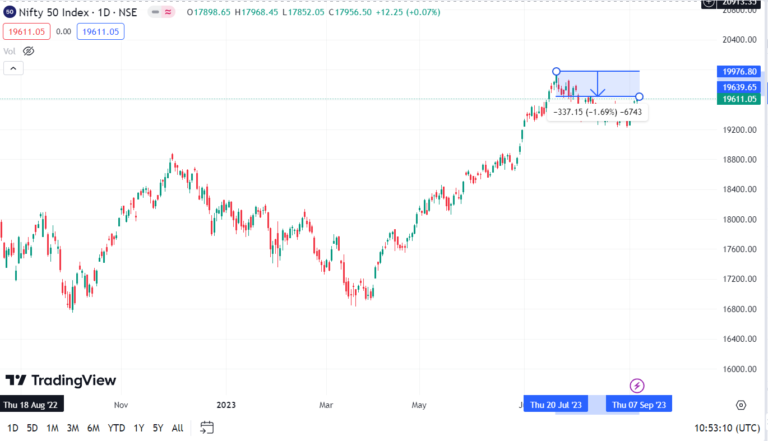
(Source: https://www.tradingview.com/)
On the flip side, Nifty IT (which measures the performance of the Indian IT Stocks) is trading almost 20% from its peak which would make it a better purchase at current levels.
So investing money in a safe (ish) instrument like Index, especially when the valuation (price) is low, could lead to better results.
PS: Not a buying recommendation.
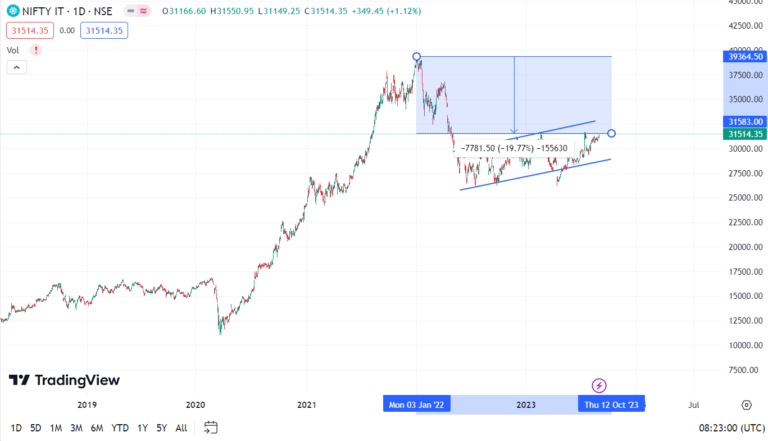
(Source: https://www.tradingview.com/)
c. Large Cap Stocks:
- These are relatively safer blue chip firms.
- Most people make a mistake of buying these firms at very high valuations. A sensible investing strategy would be to buy blue chips at a discount.
For example:
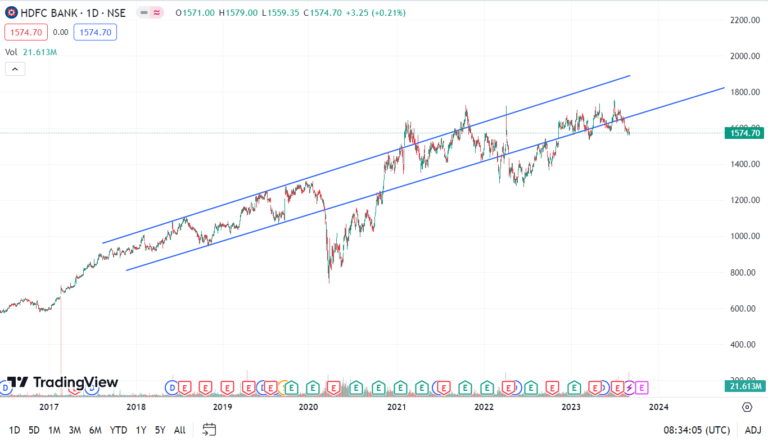
(Source: https://www.tradingview.com/)
- HDFC Bank has gone through a time correction of over 2 years (giving almost 0% returns) and is currently trading outside its channel. Stock PE is at 18 as opposed to its median PE of 25

(Source: https://www.tradingview.com/, https://www.screener.in/)
- DMART has also gone through a time correction for over 2 years and is trading at around 30% discount from its peak.
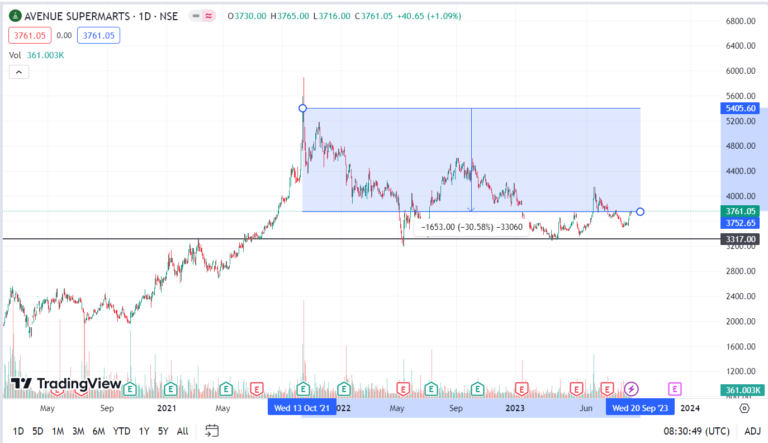
PS: Not a stock buying recommendation.
d. Small Cap or Mid Cap Stocks:
- These are more volatile and should take up a smaller percent of your portfolio.
- These stocks are high risk- high reward type of investments.
For an average investor: your portfolio should have almost 80% focus on wealth preservation (Index and Large Cap) and 20% on riskier growth assets (Small and Mid Cap; as these could give you growth).
Salary Level 2: You are earning an in-hand salary of 50-75k.
Take a look at the chart below:
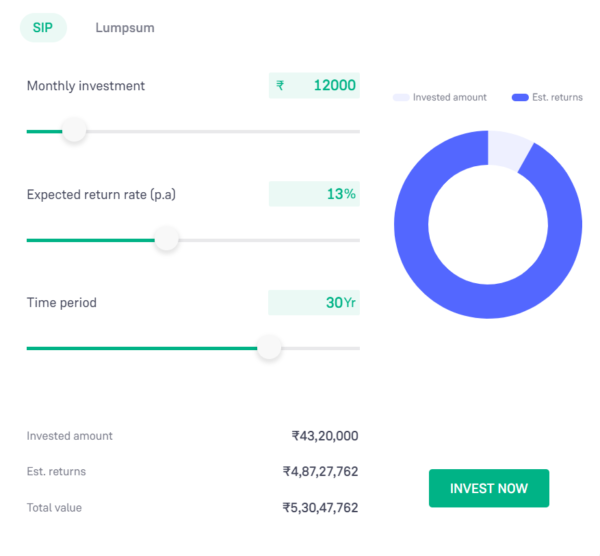
(Source: https://groww.in/calculators/sip-calculator)
With a monthly investment of INR 12000, you could end up building a corpus of 5.3 Cr.
Yes, we are again discounting the fact that inflation would eat into this money. But, the point of this example is to outline the fact that even with a small amount, a fairly large corpus could be built.
For example: with a Salary of 60K, assuming a 20% savings rate, it get us to INR 12000 as the investable amount.
Now, the question arises on how to invest this 12K monthly.
In addition to the previously mentioned strategies from Salary level 1, our strategy in this salary level will include 3 new sections:
a. Bulk Investing:
- Now given that your investment amount is relatively higher, you should take this opportunity to invest in bulk when an undervalued asset presents itself.
- For eg: HDFC Bank and Nifty IT.
- PS: Not a stock buying recommendation.
- This will help grow your portfolio exponentially faster given your higher discretionary income and holding period.
- Just being able to grow your portfolio at 16% as opposed to 12% gives you corpus of 22.1 Cr as opposed to 8.82 Cr for a monthly investment amount of 25k for 30 years.


(Source: https://groww.in/calculators/sip-calculator)
b. Cash Flow Assets:
- Focus on assets that produce cash flows.
- For eg: Dividend Stocks, Debt or Real Estate.
c. Growth Assets:
- Take more sensible risks and adjust your portfolio for a larger time horizon.
- Switch to a strategy of 60-70% focus on wealth preservation (Index and Large Cap) and 30-40% on riskier growth assets (Small and Mid Cap).
- These numbers should be adjusted as per your age and risk appetite.
Salary Level 3: You are earning an in-hand salary greater than 1 Lakh.
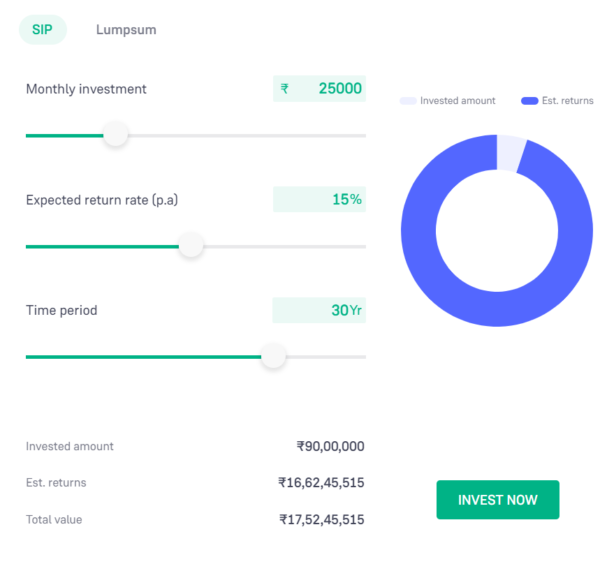
(Source: https://groww.in/calculators/sip-calculator)
With a monthly investment of INR 25000, you could end up building a corpus of 17.5 Cr.
Yes, we are again discounting the fact that inflation would eat into this money. But, the point of this example is to outline the fact that even with a small amount, a fairly large corpus could be built.
For example: with a Salary of 1L, assuming a 25% savings rate, it get us to INR 25000 as the investable amount.
Now, the question arises on how to invest this 25K monthly.
In addition to the previously mentioned strategies from Salary level 1 and 2, our strategy in this salary level will include 3 new sections around segmenting your portfolio as a means of diversification and your long term needs:
a. Retirement Planning:
- Around 25% of your portfolio can be focused for your retirement and should include safe assets purely for wealth preservation.
- This can include Index or Large Cap stocks, Bond Investing etc.
b. International Investing:
- Around 20% of your portfolio can be focused on investing internationally. This is your method of geographically diversifying your investments.
- Over time you can increase this allocation as our portfolio grows.
- For eg: US Investing can be done through ETF’s such as Vanguard 500 Index Fund ETF (VOO) which tracks the return of the top 500 largest listed companies in the US.
PS: Not a stock buying recommendation.
c. Real Estate Investment:
- Give focus on including a hard asset like Real Estate which gives you asset class diversification.
- This also adds on as a cash flow asset if you are able to rent it out efficiently.
- While there is common notion that Real Estate does not give good returns, this is not true as long as you buy good Real Estate which can give good cash flows.
For investors who are looking for advanced techniques with a focus on better returns, I have a course on Stock Market Investing which covers all the aspects from Fundamental Analysis to key concepts like Macroeconomics and Wealth building.
In Conclusion:
The guidelines mentioned in the 3 salary levels gives you a good idea on not only how to invest your salary at your current salary level but also on how you can change your investing style as your salary and your active incomes grow.
Always remember to keep track of where your money is flowing and work towards achieving your early retirement goals.
- Investing is a highly personalized experience so ensure that you have an investing style that suits your needs and preferences.
- Your salary level is one metric to decide on your investing style.
- If you are earning 25-30k, save 10-20% of your salary to invest and aim for a 13% CAGR. Focus 80% of your portfolio on wealth preservation and 20% on growth.
- If you are earning 50-75K, save 20% of your salary to invest and aim for a 13% CAGR. Focus 60-70% of your portfolio on wealth preservation and 30-40% on growth as per your age and risk appetite.
- If you are earning >1L, save 25% of your salary to invest and aim for a 15% CAGR. Segment your portfolio into different verticals for hedging and for your long term needs.
- Ensure to switch your investing style as your salary and risk appetite changes.
- Save X% of your salary
- Grow your active income
- With a growing salary, increase your savings rate (X%)
- Invest every month (timing the market is tough)
- Start small, with low risk assets (eg. Index Funds)
- Fill up your emergency fund (i.e 6X your monthly expenses)
- Keep a long term perspective (3 year plus)
- With experience, you can increase your risk (eg. buying small/mid caps)
- Have a large enough (liquid) portfolio
- Diversify your investments across Asset Classes with time (eg. Real Estate)
- Keep debt less than 33% of your cash flows
- Create cash flow assets (eg. Real Estate, Business etc)
- Build a portfolio of income streams (Stock Markets, Active Income, Real Estate)
- With growth in portfolio learn hedging (Eg. diversifying across geography)
- Pick up advanced investing techniques (Eg. when to bulk buy). This can help you generate better returns
Now that you know how you can Invest your Salary to create a big portfolio, here’s another blog post on How you can Improve your relationship with Money
